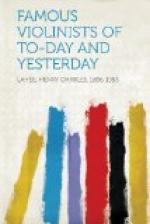In the meantime every effort was being made to secure Christian burial. The spiritual tribunal decided that Paganini had died a good Catholic. The bishop refused to accept the decision, and an appeal to the archbishop was unavailing. Eventually the case was brought before the Pope himself by the friends of the dead man, and the Pope overruled the decision of the archbishop and ordained that Christian burial should be accorded to the artist. On the 21st of August, 1843, the Conte di Cessole took away the coffin from Villafranca, and interred it in the churchyard near Paganini’s old residence at Villa Gavona, near Parma. Thus even after death he was the victim of superstition, as he had been during his lifetime.
Paganini resolved not to publish his compositions until after he had ceased to travel, for he was aware that his performances would lose much of their interest if his works were available to everybody. He seldom carried with him the solo parts, but only the orchestral scores of the pieces that he played. His studies were pronounced impossible by some of the best violinists of the day, so great were the difficulties which they contained, and in his mastery of these difficulties, which he himself created, may be found the true secret of his success. People accounted for it in many ways, one man declaring that he saw the devil standing at his elbow, and others stating that he was a child of the devil, and that he was bewitched.
His compositions are remarkable for novelty in ideas, elegance of form, richness of harmony, and variety in the effects of instrumentation. Few compositions ever attained such fame as the “Streghe,” of which the theme was taken from the music of Suessmayer to the ballet of “Il Noce di Benevento.”
While it may be readily admitted that many of the effects with which Paganini dazzled the multitude were tainted with charlatanism, yet the fact remains that no one ever equalled him in surmounting difficulties, and it is doubtful if, among all the excellent violinists of the present day, any of them compares with that remarkable man.
Some of his studies have been adapted to the pianoforte by Schumann and by Liszt, and of the collection arranged by Liszt, consisting of five numbers from the Caprices, Schumann says: “It must be highly interesting to find the compositions of the greatest violin virtuoso of this century in regard to bold bravura—Paganini—illustrated by the boldest of modern pianoforte virtuosi—Liszt.” This collection is probably the most difficult ever written for the pianoforte, as its original is the most difficult work that exists for the violin. Paganini knew this well, and expressed it in his short dedication, “Agli Artisti,” that is to say, “I am only accessible to artists.”
It is doubtful whether any violinist ever lived concerning whom more fantastic stories were told. His gruesome aspect, his frequent disappearances from public life, his peculiar habits, all tended to make him an object of interest,—and interest is sometimes shown in eagerness to hear anything at all about the subject.




